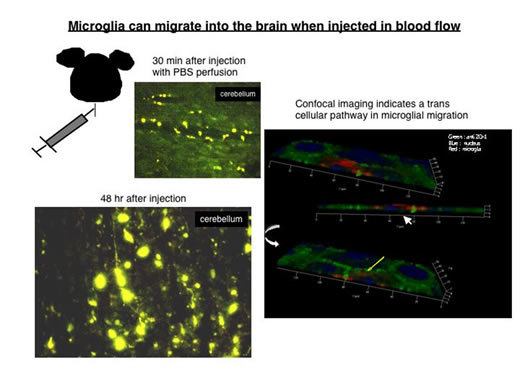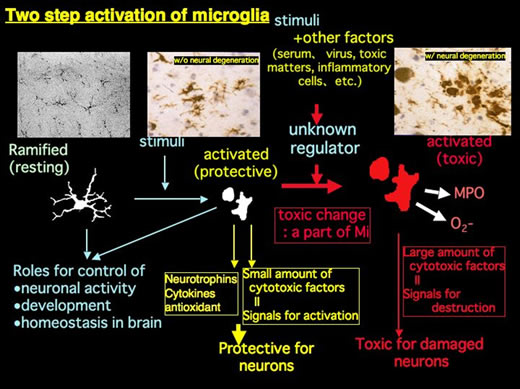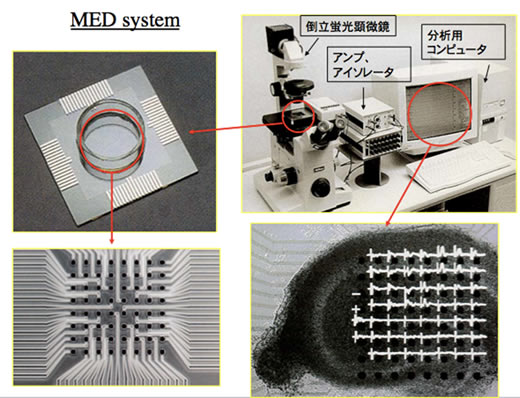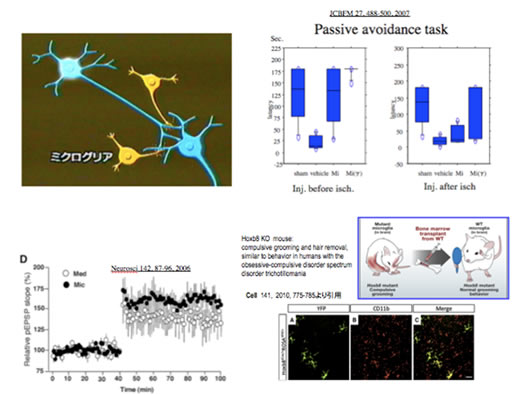1 Elucidation of the mechanism of microglia in the regulation of higher
brain function
- (1) Brain-specific migration of microglia, and its application in brain-targeted drug delivery
- (2) Microglial toxic changes in neural disorders
- (3) Control of higher brain functions by microglia and their subtypes
(1) Brain-specific migration of microglia, and its application in brain-targeted
drug delivery
Since the brain has a blood-brain barrier, there is almost no infiltration of substances and cells from peripheral tissue, and it is difficult to transport drugs and genes across it.
In fact, there is almost no infiltration of immune cells, such as T-cells and macrophages in the normal brain. However, glucose and amino acids are selectively taken up through transport molecules, but the blood-brain barrier remains intact during this process. We discovered that special types of cells can selectively invade the brain without disrupting the blood-brain barrier. Based on the observation with confocal microscopes and electronic microscopes, we believe that invasion by these cells is through trans-endothelial cell migration (transcytosis). After preparing microglial cells from the brain, and staining with fluorescent markers, we injected them intravenously into mice, and found that microglia specifically aggregate in the brain but not not migrate at all to peripheral organs. Using such properties, we introduced genes in interest to express in purified microglia, and were successfully indicated expression target genes in the brain by injecting such microglia into peripheral veins. Therefore, we concluded that it is possible to utilize gene therapy and a drug delivery system targeting the brain by altering genes to compensate for diseased genes, and injecting microglia which have taken up drugs beforehand intravenously, and we are carrying out research on this.

Recently, we were successful in isolating molecules which can mimic the intra-cerebral invasion of microglia, and we obtained a patent for this. We are carrying out development with the aim of brain-targeted drug delivery by linking molecules such as these with drug protein genes, artificial transporters, and other molecules. This system has higher brain selectivity compared with other brain technology, and also has the feature of keeping the blood-brain barrier intact. This system may also introduce drugs to the brain at a high migration rate, and therefore we are working with pharmaceutical companies to carry out development with the aim of applying this to new methods of treating brain diseases.

(2) Microglial toxic changes in neural disorders
It is known that microglia are activated in almost all brain diseases, including Parkinson’s disease, Alzheimer’s disease, and other diseases with neural degeneration, brain tumors, epilepsy, and schizophrenia. In addition, microglia are activated not only in diseases but in disorder of biological responses and in functional disorders. Activated microglia indicate opposite charactreristics, and both types of activation response occur in the brain; one of which protects brain cells, and the other proactively excludes damaged cells. We believe that there are two steps in the activation of microglia, based on an analysis using our precisely isolated microglia and cell lines, and based on gene modifications. In other words, we believe that microglia, which exhibit neuro-protective activity, undergo a toxic change due to an effect on them. Recently, we were able to demonstrate that it is possible to do in vivo imaging of such changes using PET ligands.

(3) Control of higher brain functions by microglia and their subtypes
Recently, there have been many reports on the possibility of microglia being deeply involved in high-level brain functions, such as memory, learning, and development of psychological functions. We have been looking into the effects of the introduction of microglia on memory and learning behavior using a brain slicer and mice to which in vivo cells have been introduced or to which gene modifications have been made. Additionally, recently we have been introducing microglia to model animals with functional diseases, such as depression, to look into the activity on such diseases and therapeutic effects.















